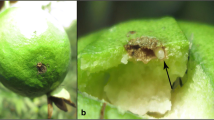Abstract
Coffee canopy damage studies with the yellow-headed borer, Dirphya nigricornis Olivier were conducted on mature plants. Single borer infestation of the pest in coffee plantations were established. Age-induced destruction of the coffee canopy was evidenced by the withering of branches, stems and nodes and were correlated to larval developmental days 0-260. Larval frass excretion was immense being 16,214.91 and 12,076.90 g for female and male beetles, respectively and represented direct physical damage by the pest to plants. Analysis of accumulated data of physical measurement on coffee yield components in the three categories of canopy partitions relative to height of the stem above the ground showed that damage to plants by the pest adversely affected them. Generalized non-linear equations relating berries, pinheads, flowers and leaves (P = 0.05 to P = 0.001) to heights of canopy partition above ground level are described. The physical model developed approximates the responses of the canopy to infestation by the beetle, and shows that these were either depressed or enhanced depending on whether the yield components measured were in the bottom, mid or top partitions of the canopy. Threshold damage constants for leaves (0.34), berries (0.41), pinheads (1.54) and flowerbuds (1.07) which caused variability were established.
Résumé
Les études des dégâts faits a la canopie du café par un insect perceur à tête jaune, Dirphya nigricornis Olivier, ont été faites sur les caféiers en plein maturité. Plusieurs infestations singulières, simulant les infestations des plantations du café dans les champs, ont été etablies. La déstruction de la canopie de café promue par l’âge était mise en évidence par le flétrissement des branches, troncs et nodosité et était en correlation avec la période du dévelopement larvaire (0-260 jours). Les excretions larvaires étaient immenses et représentaient directs dégâts physiques aux Caféiers par le peste. Des données accumulées des mésures physiques sur les composantes du rendement de café présentées en trois catégories des partitions de la canopie suivant le hauteur présent au dessus de la terre ont été analysisées en vue d’établir l’effet (s’ilyena) de la peste sur les mêmes données. Les équations non-linéaires relatant les baies, les tete d’épingle, les fleurs et les feuilles (P = 0,05 et P = 0,001) aux différent hauteurs de la partition de la canopie au dessus de la terre sont décrites. Le modèle physique dévelopé approxime les réactions de la canopie aux infestations par le coléoptère négativement ou positivement selon que les composantes du rendement mésurées se trouvent dans l’une des trois partitions de la canopie: bas, milieu et sommet. Seuil dommage constante étaient étabbies partout.
Similar content being viewed by others
References
Anonymous (1980) Annual report 1980. Coffee Board of Kenya.
Crowe T. J. (1962) The biology and control of Dirphya nigricornis Olivier., a pest of coffee in Kenya (Coleoptera: Cerambycidae). J. Ent. Soc. Sth. Afr. 25, 304–312.
Dethier V. G. (1970) Chemical interactions between plants and insects. In Chemical Ecology. Edited by Sondheiner E. and Someone J. B.). London Academic Press.
Donley D. E. and Worley D. P. (1976) Insect impact on production of oak timber. Ibid. 223, 63–66.
Hammond R. B. and Pedigo L. (1982) Determination of yield loss relationship for two soybean defoliators by using simulated insect-defoliation techniques. J. econ. Em. 75, 102–107. House H. L. (1961) Insect nutrition. A. Rev. Ent. 6, 13–36.
Le Pelley R. H. (1959) Agricultural Insects of East Africa. East African High Commission, Nairobi, Kenya.
Le Pelley R. H. (1968) Pests of Coffee. Longmans, London.
Le Pelley R. H. (1973) Coffee Pests. A. Rev. Ent. 18, 121–142.
Purseglove J. W. (1968) Tropical Crops: Dicotyledons 2. Longmans, London.
Rodrigues C. J., Bettern Court A. J. and Rijo L. (1975) Races of the pathogen and resistance to coffee rust. Ann. Rev. Phytopathol. 13, 49–70.
Taylor W. E. and Bardner R. (1970) Energy relationship between larvae of Phaedon cochlearine (Coleoptera: Chrysomellidae) and turnip plants. Ent. exp. appl. 13, 403–406.
Author information
Authors and Affiliations
Rights and permissions
About this article
Cite this article
Khaemba, B.M., Wanjala, F.M.E. Evaluation of Coffee Canopy Damage by Dirphya nigricornis Olivier (Coleoptera: Cerambycidae). Int J Trop Insect Sci 9, 547–555 (1988). https://doi.org/10.1017/S1742758400011139
Received:
Revised:
Published:
Issue Date:
DOI: https://doi.org/10.1017/S1742758400011139




